Badminton is a very precise sport, where every centimeter (or every inch) can count and tilt the balance between glory or defeat. In the following post, we are going to explain all the important measurements in badminton, starting from the more shared court measurements and following with other not so much shared measurements, such as shuttlecock or racket measurements
Do you want to improve your badminton game? Then be sure to sign up for Badminton Famly+ by clicking here. Founded by former World Champion Thomas Laybourn, Badminton Famly+ is the best online training platform for badminton.
If you want to beat that other player in your club that always manages to find your weak points, you should sign up for the Badminton Famly+ online training program. You can read our in-depth review of this e-learning platform created by a world champion following this link.
Court measurements
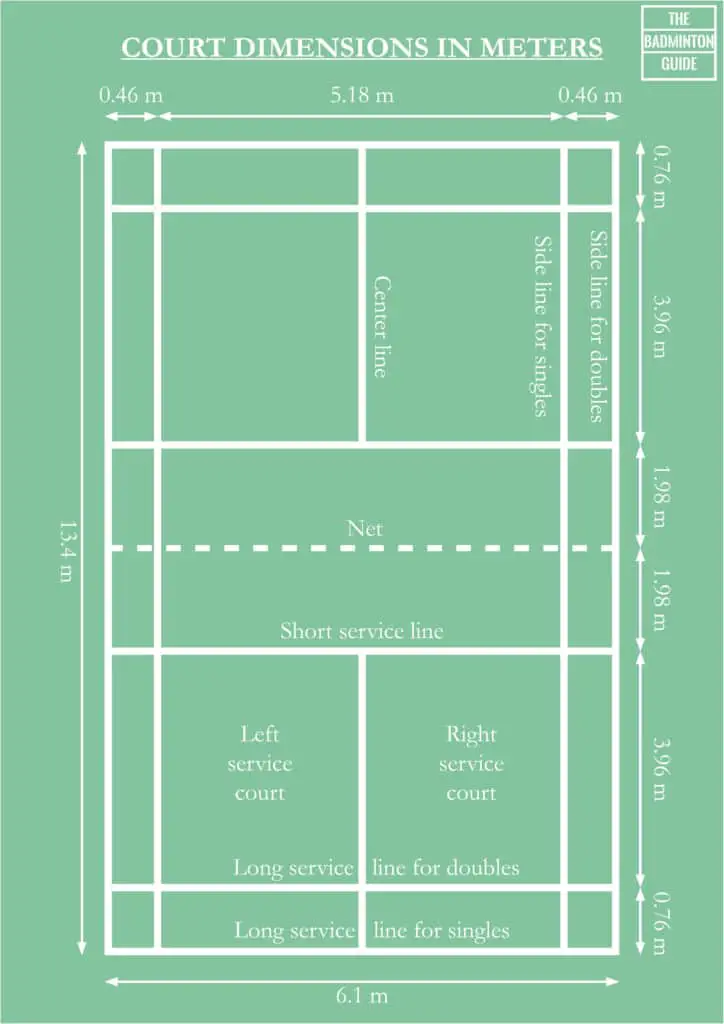
The badminton court is rectangular and it is divided by a net into two equal rectangles. The standard setting for a court is to be marked for both singles and doubles matches. The doubles court is wider than the singles one, but both are the same length. The only exception to that statement is that the doubles court has a different back serve line, which is shorter than the singles one. This often causes confusion to new players.
The lines marking the court are 40mm (1.6 inches) wide (and preferably white or yellow in colour). When using badminton mats, the correct mounting of them will ensure that these measurements are correct. These lines are part of the area which they define, so both in the image above and in the data below the lines are included in the measurements.
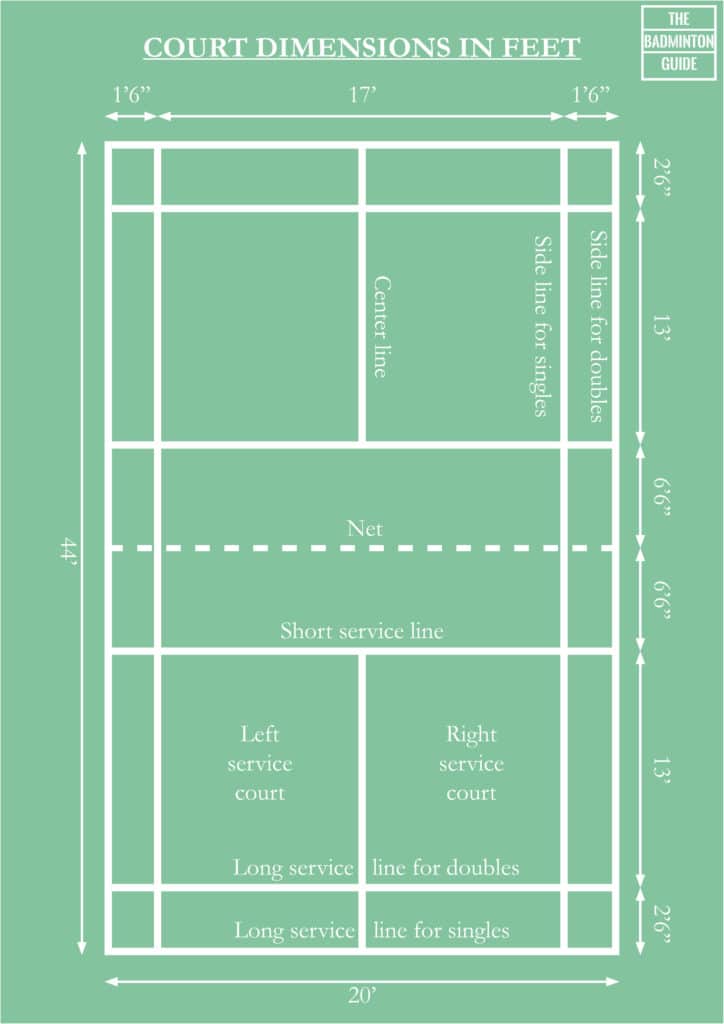
Court measures for singles matches
As you can see from the picture above, when a singles match is being played, the following measures are to be followed:
- Total width: 5.18 m (17 ft)
- Total length: 13.4 m (44 ft)
- This length is divided into two equal parts, 6.7 m (22 ft) each
- Front service line distance to the net: 1.98 m (6 ft 6 inch)
Court measures for double matches
As you can see from the picture above, when a doubles match is being played, the following measures are to be followed:
- Total width: 6.1 m (20 ft)
- Total length: 13.4 m (44 ft)
- This length is divided into two equal parts, 6.7 m (22 ft) each
- Front service line distance to the net: 1.98 m (6 ft 6 inch)
- Rear service line distance to the back: 0.76 m (2 ft 6 inch)
If you would like to know more about the court measurements, be sure of my Badminton Court Size post, where these dimensions are explained in more detail.
Posts & Net measurements
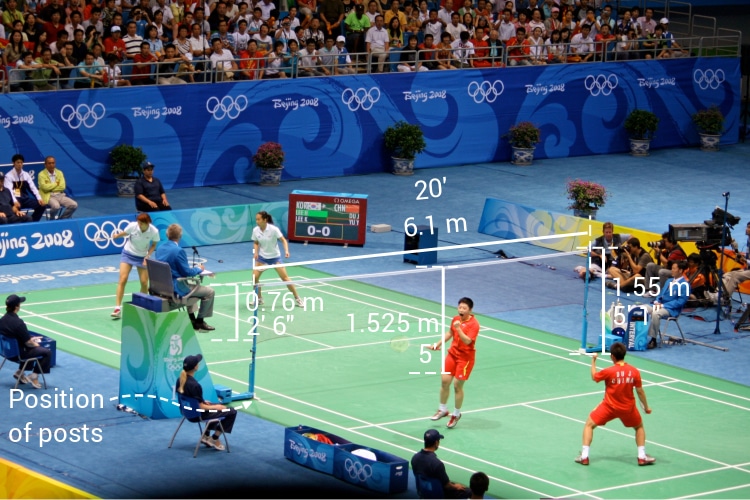
Equally important to the size of the court itself are the sizes of the posts and the net. They go together in the same group because they are interlinked, being two elements but forming one single object.
Post measurements
The posts have to be 1.55 m (5ft 1 inch) in height from the surface of the court. Moreover, when the net is fully stretched in the dimensions we will see below or on the picture above, the posts have to remain vertical. In addition to that, the posts must be placed on the double sidelines irrespective of whether singles or doubles is being played. You can see that in the picture above. Finally, the posts or its supports shall not extend into the court beyond the side lines.
Net measurements
Regarding the net, the Badminton World Federation is also very specific about it. The net has to be made of fine cord of dark colour and even thickness, with a mesh of not less than 15 mm and not more than 20 mm. The net shall be 760 mm (2 ft 6 inch) in depth and 6.1 m (20 ft) wide (like the doubles court). The top of the net shall be edged with white tape, which has to be doubled over a cord or cable running through the tape. This tape shall be white and shall rest upon the cord or the cable. Moreover, the cord or cable shall be stretched firmly, flush with the top of the posts.
The top of the net from the surface of the court shall be 1.525 (5 ft) meters at the centre of the court and 1.55 m (5ft 1 inch) over the sidelines for doubles. There shall be no gaps between the ends of the net and the posts. If necessary, the full depth of the net at the ends shall be tied to the posts.
If you would like to know more about net and post dimensions, be sure to check our Badminton Net Dimensions post.
Shuttlecock measurements
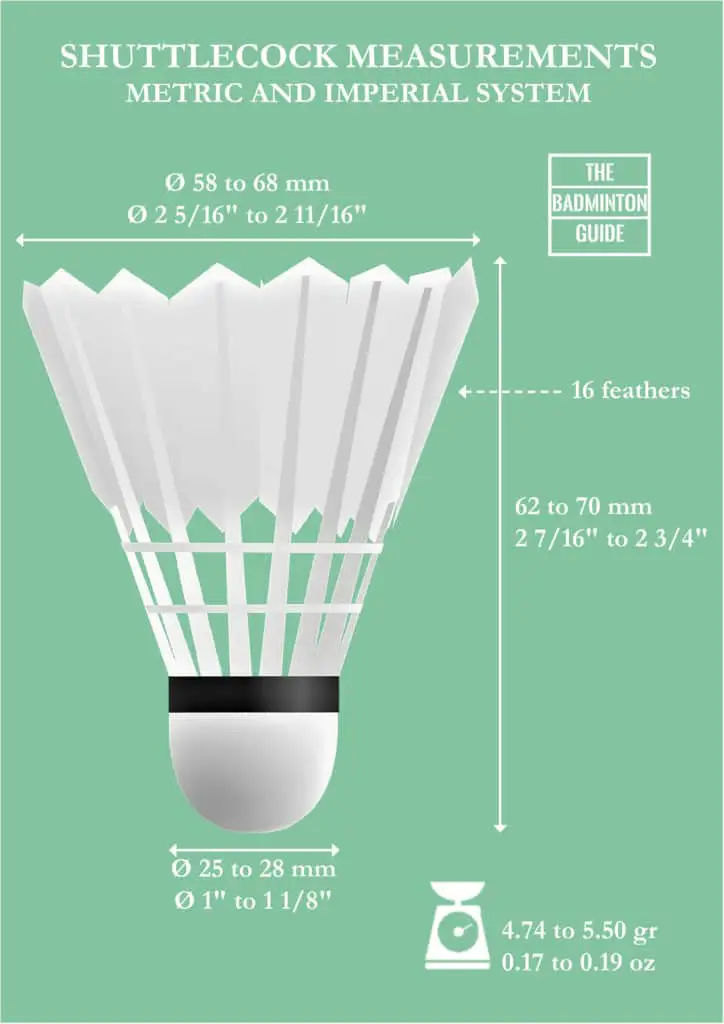
The shuttle shall be made of natural and/or synthetic materials. From whatever material the shuttle is made, the flight characteristics generally shall be similar to those produced by a natural feathered shuttle with a cork base covered by a thin layer of leather. When in a tournament, it is advisable to use one of the BWF’s preferred suppliers as a brand.
Feathered Shuttle
The shuttle shall have 16 feathers fixed in the base. The feathers shall have a uniform length between 62 mm (2.5
If you are wondering what feathered shuttlecock is the best, I personally recommend the Yonex Aerosensa AS 20. It has a great balance between durability and price. You can buy in on Amazon following this link. My advice would be to try the AS 10, 20 & 30 and then decide which one suits best your needs.
Non-Feathered Shuttl e
The skirt, or simulation of feathers in synthetic materials, shall replace natural feathers. The base shall be as described in the previous section. Measurements and weight shall be also as described in the previous section. However, because of the difference in the specific gravity and other properties of synthetic materials in comparison with feathers, a variation of up to 10 per cent shall be acceptable.
Subject to there being no variation in the general design, speed and flight of the shuttle, modifications in the above specifications may be made with the approval of the Member Association concerned, in places where atmospheric conditions due to either altitude or climate make the standard shuttle unsuitable.
If you are wondering what non-feathered shuttlecock is the best, I personally recommend the Yonex Mavis 300. They are durable plastic shuttles. They are not comparable to the feather shuttles in terms of flight, but their price and durability are hard to beat in the non-feathered line. You can buy them on Amazon following this link.
Racket measurements
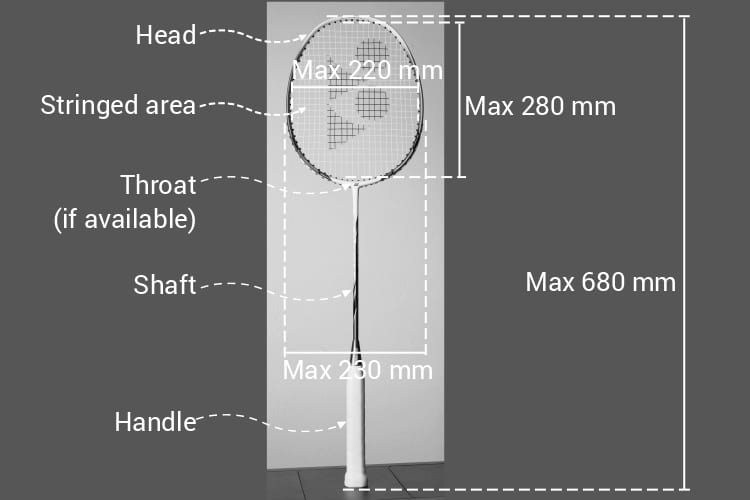
The racket is a very important element in the game as it is, in the end, the tool that the players use to hit the shuttlecock and win matches. It is the object that players blame (and break) when things go wrong and their game is not up to their expectations. Being such an important part of the game, it is also heavily controlled in order to ensure that nobody gains an undesired advantage due to the racket only.
As the main dimensions, the frame of the racket (which basically means the total of the racket) shall not exceed 680 mm (2 ft 2.8 inch) in overall length and 230 mm (9.1 inch) in overall width. The frame consists of the following parts:
- The head: This part surrounds (and bounds) the stringed area. This is the part of the racket that breaks most often.
- The stringed area: This is the part of the racket with all the strings and it is designed to be the part of the racket that a player hits the shuttle with.
- The throat: This part is not present in all the designs but, when it is, it works as a connector between the shaft and the head.
- The shaft: This part connects the handle to the head. It is basically the “stick” that goes from one to the other.
- The handle: This is the part of the racket intended to be used as a grip zone for the player
Out of these parts, the stringed area, being the one with which the player hits the shuttle, is the one that gets more detailed attention in terms of sizes.
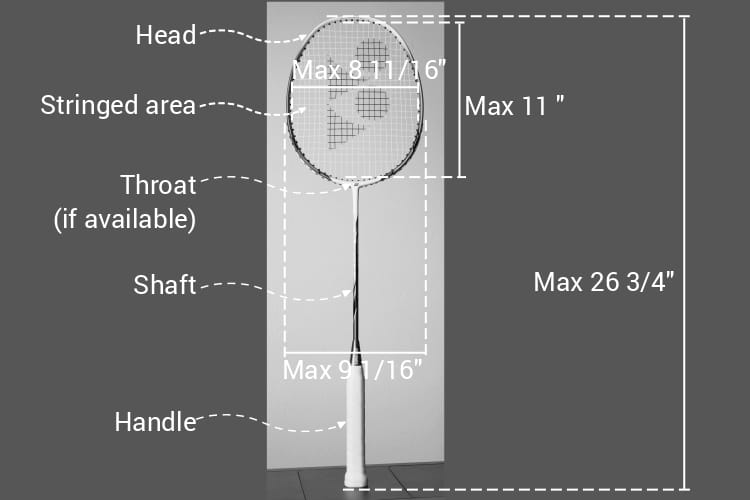
The stringed area
The stringed area shall be flat and consist of a pattern of crossed strings either alternately interlaced or bonded where they cross. The stringing pattern shall be generally uniform and, in particular, not less dense in the centre than in any other area. The stringing pattern shall not exceed 280 mm (11
The racket
The racket shall be free of attached objects and protrusions, other than those used solely and specifically to limit or prevent wear and tear, or vibration, or to distribute weight, or to secure the handle by cord to the player’s hand, and which are reasonable in size and placement for such purposes; and shall be free of any device that makes it possible for a player to change materially the shape of the racket.
Additional measurements and curious facts
A rather surprising missing measurement is the height of the ceiling above the court, which is nowhere to be found within the Laws of Badminton from the Badminton World Federation. However, this is usually covered in national federations. For example, in the United Kingdom, the minimum height for recreational or club level is 7.6 meters. This minimum measurement goes up to 9.1 meters for regional, national or international competitions. In Spain, on the other hand, there is only a common height of 7.5 meters for all
Want to bring your badminton to the next level? Check Badminton Famly+
If you want to improve your game, you can sign up for the Badminton Famly+ program following this affiliate link. By following this link, you will receive 30% off the first month.
This e-learning platform is co-created by Thomas Laybourn, Danish player, former World number 1, World Champion, and professional coach.
They are doing an awesome job with their online training and they have an incredible amount of information on how to improve your game.
With such trustworthy founders, it is no surprise that this is, by far, the best online training program I have been able to find.
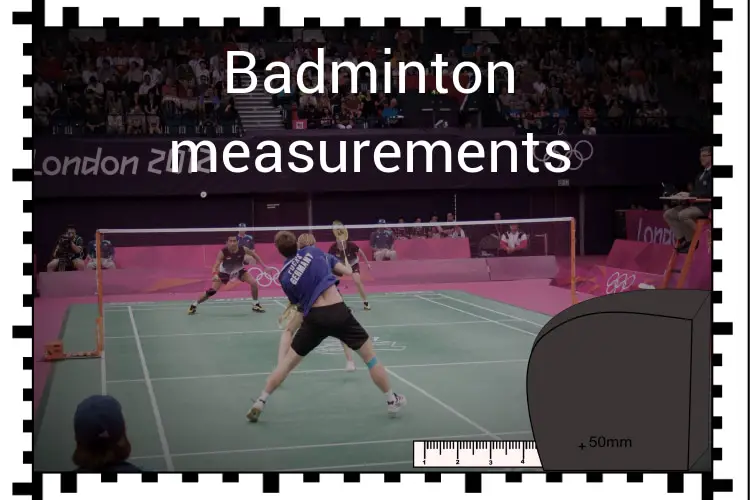
Thanks for the good info